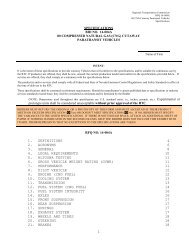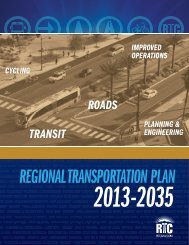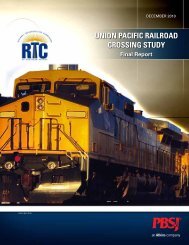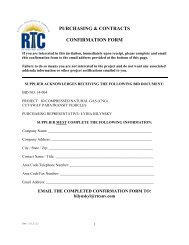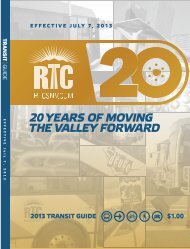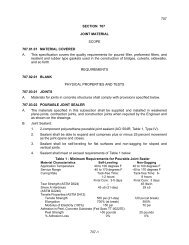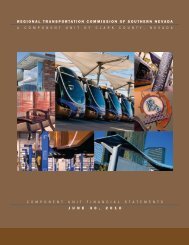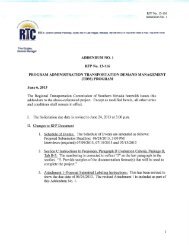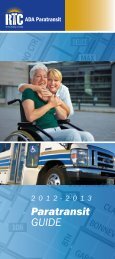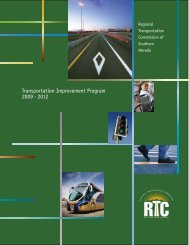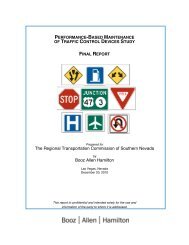(Blue Diamond Road) Corridor Study - Regional Transportation ...
(Blue Diamond Road) Corridor Study - Regional Transportation ...
(Blue Diamond Road) Corridor Study - Regional Transportation ...
Create successful ePaper yourself
Turn your PDF publications into a flip-book with our unique Google optimized e-Paper software.
6. SR-160 <strong>Corridor</strong> Improvement Plan RTC SR-160 <strong>Corridor</strong> <strong>Study</strong><br />
6.4.3 Bus Signal Priority<br />
AASHTO’s “Guide for Park & Ride Facilities” 12 lists eleven different types of Bus Signal<br />
Priority strategies, which are as follows.<br />
Unconditional priority: priority is given whenever a bus detector requests it from<br />
signals.<br />
Conditional priority: includes variables that may limit priority given, such as bus<br />
occupancy, queue length, and time since last priority was granted.<br />
Phase: part of the traffic signal time cycle allocated to any combination of traffic<br />
movements receiving right-of-way simultaneously during one or more intervals.<br />
Green extension: green phase is extended when bus is nearby to allow it to go<br />
through.<br />
Special phase: a special green phase is injected into the normal phase sequence<br />
while all other phases are stopped.<br />
Compensation: green time is allocated to a non-priority phase that was truncated to<br />
make up for lost time.<br />
Red truncation: if the bus arrives at an intersection during the beginning or middle<br />
of a red phase, the red phase is truncated and green phase is injected to allow the<br />
bus to go through.<br />
Early start: when bus arrives at intersection during a red, green follows quicker than<br />
usual.<br />
Green recall: a green phase is displayed each cycle whether demand exists or not.<br />
Synchronization: timing groups of traffic signals along an arterial to provide for the<br />
smooth movement of traffic with minimal stops.<br />
Phase suppression: one or more non-priority phases with low demand may be<br />
omitted from the normal phase sequence.<br />
The strategy implemented at queue-jumping lane intersections would likely include one of<br />
the TSP solutions listed above, or it could simply provide a green signal to the queuejumping<br />
lane approximately five to ten seconds prior to the green signal for the general<br />
traffic lanes, either on every cycle or only when a bus is detected. (All buses will be<br />
equipped with TSP emitters.) Such decisions would need to be made on a case-by-case<br />
basis at each intersection.<br />
TSP can be programmed to activate only in the peak direction during peak periods, or only if<br />
buses are running behind schedule (as determined by the bus operator). It is likely that<br />
12 Ibid, p. 50<br />
6-7



